Christians in San Pedro Cutud — a neighborhood in Pampanga, Philippines — canceled the annual Good Friday crucifixions for the second year in a row in response to federal limits on gatherings to curb the spread of Chinese coronavirus.
President Rodrigo Duterte banned mass gatherings for Holy Week in the greater Manila Metropolitan area and several other parts of the country documented rapidly increasing numbers of Chinese coronavirus, threatening to shut churches down if they defied the ban. The Catholic Church has largely complied, offering online services, but some around the country participated in their longstanding worship rituals, anyway — albeit wearing masks, face shields, and other protective gear.
“No more religious gatherings. Full stop!” Duterte spokesman Harry Roque warned this week.
Outside of Manila, regular reenactments of the Passion of Jesus Christ occurred as they have for decades, though some rescheduled the events, potentially to limit attendance. In Mulanay, a beachside reenactment yielded dramatic images of actors dressed as Romans accompanying an actor portraying Jesus carrying a cross along the coast on Wednesday.
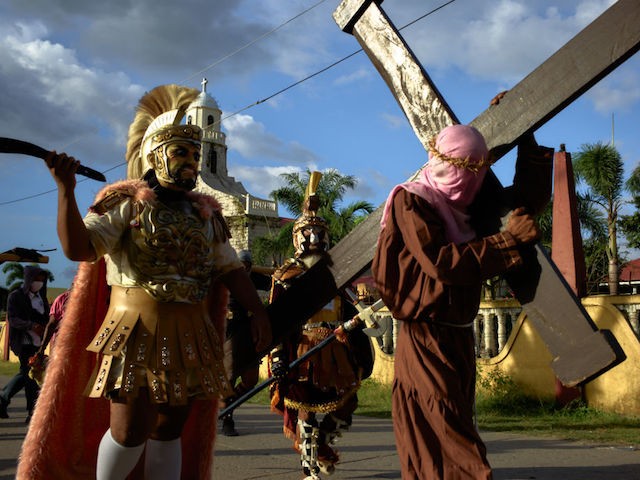
Catholic devotees of the town of Mulanay wear costumes as they reenact the passion of the Christ as part of their annual tradition during holy week, on March 31, 2021 in Mulanay, Philippines. (Photo by Jes Aznar/Getty Images)
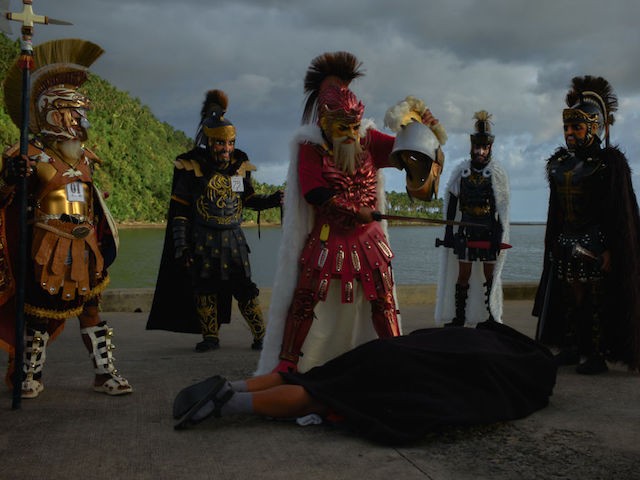
Catholic devotees of the town of Mulanay wear costumes mimicking Roman soldiers as they reenact the passion of the Christ as part of their annual tradition during holy week, on March 31, 2021 in Mulanay, Philippines. (Photo by Jes Aznar/Getty Images)
Pampanga, only about a two-hour drive from Manila, attempted to thwart Christians seeking to crucify themselves by removing crosses that typically stand on a hill in San Pedro Cutud, waiting to be filled on Good Friday.
“Mass gathering is prohibited so as to prevent the spread of Covid [Chinese coronavirus],” Eric Bangal, a local official, told reporters. “It is prohibited to do any act of penance or flagellation. And whoever violates this rule will be apprehended by the police. We are encouraging everyone to comply with these rules. It is for our own good against the spread of Covid-19.”
Ruben Enaje, the man who holds the record for enduring the most crucifixions in his life, lamented that he would not be able to fulfill his vow to God for the second year in a row. Prior to 2020, Enaje had been crucified for 33 consecutive years in San Pedro Cutud.
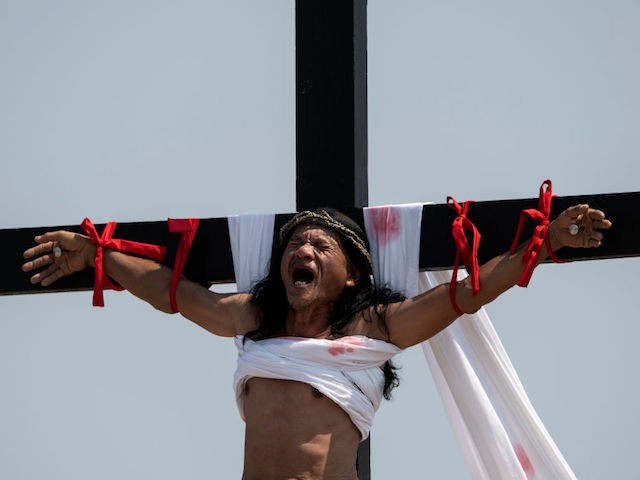
Philippine Christian devotee Ruben Enaje, 58, reacts as he is nailed to a cross during a reenactment of the Crucifixion of Christ during Good Friday ahead of Easter in the village of Cutud near San Fernando on April 19, 2019. (NOEL CELIS/AFP/Getty Images)
Enaje told the Philippine Inquirer that he felt “sadness” at not having the opportunity to repeat the tradition. Had the pandemic not occurred, he would have endured his 35th crucifixion on Friday.
“His two pairs of steel nails will remain unused, soaked in alcohol inside a glass bottle,” the Inquirer noted. The town has reportedly relocated the crosses on another hill, where Enaje spent his day this year praying.
Enaje, a carpenter and house painter, explained in an interview with the Manila Standard last year that he began the tradition in 1986 after surviving a fall from the third floor of a building unscathed while completing a job.
“While I was falling I uttered the words ‘Dios ko!’ (‘My God!’), and the next thing I knew I was on the ground, but fully conscious!” Enaje said at the time. “It was a miracle I survived the fall without a bone broken. In fact, when I was on the ground, I did not stand up immediately thinking I broke my legs and body, but after a few moments I found out I was okay. I owe my life to Jesus that’s why every Good Friday I have to undergo the crucifixion ritual.”
San Pedro Cutud crucified eight men and one woman in 2019, the last time the government allowed the ritual. While the town did not allow public crucifixions — which attract as many as 50,000 people on some occasions — at least one man was crucified this week in the Philippines: Greg Meer Horton, who performed his ritual away from the public eye in Batangas, on the other side of the greater Manila area.
“This act of crucifixion is my way of sacrifice this Holy Week. I used to do this as a promise to our Lord for repentance, but last year it was postponed due to quarantine restrictions. So, this year, I am pushing through with it even before Good Friday,” Horton told reporters. Horton’s crucifixion on Tuesday was his eighth.
While crucifixions were rare this year, Manila residents defied Duterte’s lockdown to perform traditional street flagellations in small numbers, wearing masks while receiving lashings on the street.
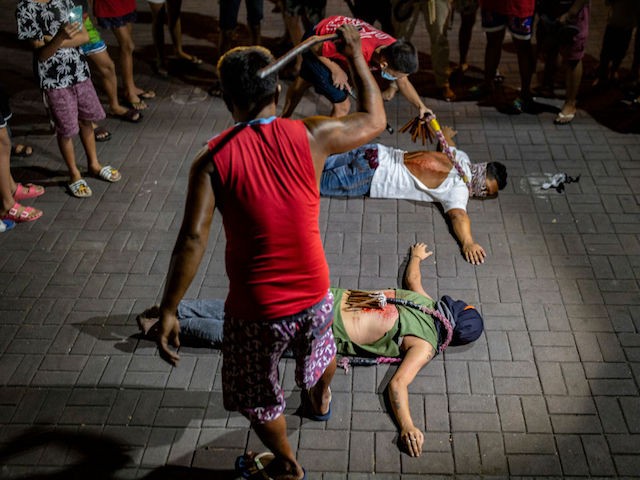
Barefoot flagellants have their bloodied backs whipped as penance outside a closed church, defying government orders to avoid religious gatherings and stay home to curb the spread of the coronavirus, as they commemorate Good Friday on April 2, 2021 in Manila, Philippines. (Ezra Acayan/Getty Images)
“I prayed for my parents. I’m thankful they haven’t gotten sick,” Melvin Devibar, one of those participating in the flagellations, told Reuters. “Even during this pandemic, I don’t believe we will be affected by COVID as long as we pray.”
Priests largely did not defy the ban on indoor services, but did organize masked processions in which they showered crowds with holy water in the capital.
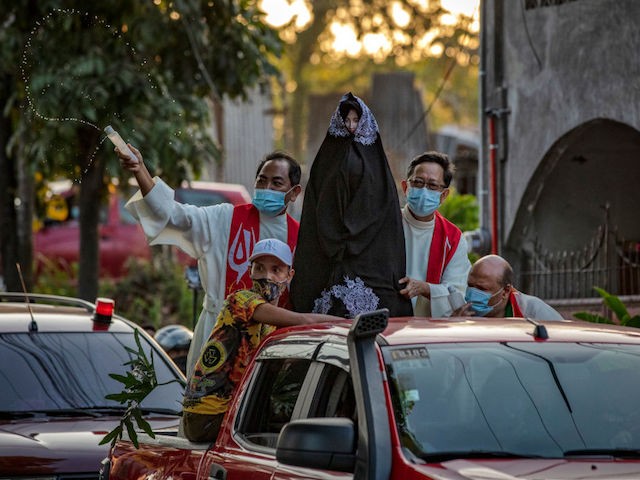
Priests aboard a pickup truck make door to door visits to bless residents to avoid the spread of [Chinese coronavirus] while commemorating Good Friday on April 2, 2021 in Quezon city, Metro Manila, Philippines. (Ezra Acayan/Getty Images)
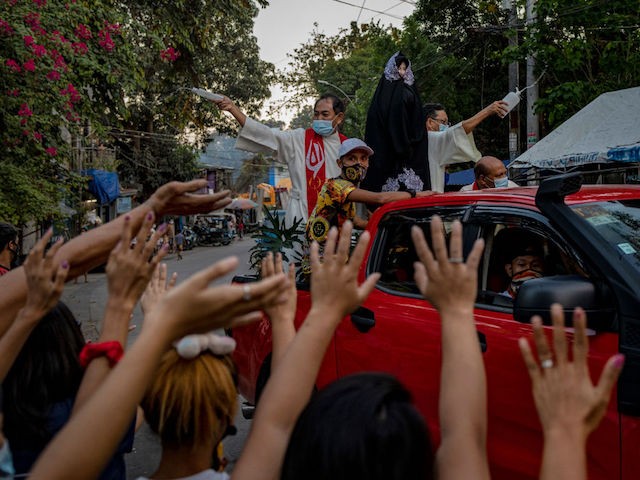
Residents are blessed by priests aboard a pickup truck to avoid the spread of [Chinese coronavirus] while commemorating Good Friday on April 2, 2021 in Quezon city, Metro Manila, Philippines. (Ezra Acayan/Getty Images)
Some devotees pray outside the Minor Basilica of the Black Nazarene in Quiapo, Manila while church activities are suspended because of the COVID-19 pandemic. No traditional procession will be held this Good Friday to commemorate the liturgical feast of the Black Nazarene. pic.twitter.com/qMQq0C3SNq
— Lady Vicencio (@lady_vicencio) April 1, 2021
The Philippines is one of the most Catholic countries in the world. About 80 percent of its population is believed to be Catholic, and over 90 percent subscribe to some form of Christianity. Good Friday is one of the holiest days in Christianity, when Christians mourn the crucifixion of Jesus. Catholics typically mark the holiday with fasting, processions, and other holy services. Self-flagellation and actual crucifixion is a tradition unique to the Philippines, however, which the Vatican has often attempted to distance itself from.
Christians observe Good Friday traditions in anticipation of Easter, the holiest day of the year in Christianity, which marks the resurrection of Jesus following his crucifixion.
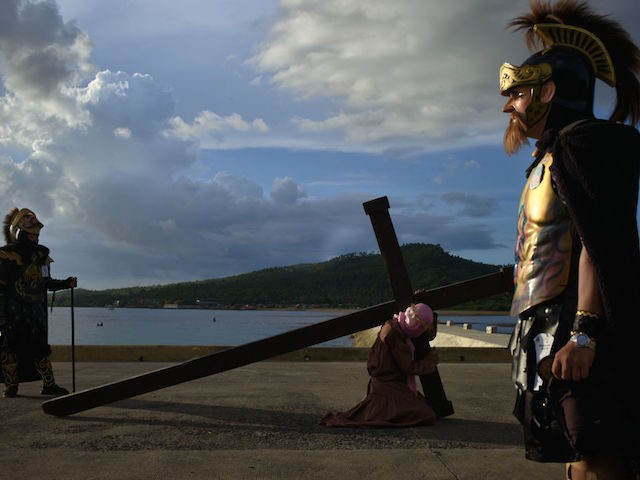
COMMENTS
Please let us know if you're having issues with commenting.